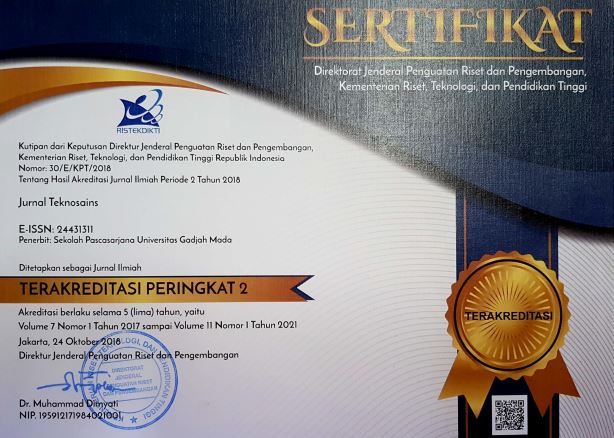Jejak karbon pada tahap operasional agro-eduwisata kota mataram menggunakan pendekatan penilaian daur hidup
Joni Safaat Adiansyah(1*)
(1) Fakultas Teknik, Universitas Muhammadiyah Mataram
(*) Corresponding Author
Abstract
Keywords
Full Text:
PDFReferences
[1] J. S. Adiansyah, “Pipeline Program CDM di Indonesia: Sebuah Peluang dan Tantangan untuk Industri Pertambangan,” Jurnal Teknosains, vol. 1, pp. 7–15, 2011.
[2] P. A. Mardika, “Permana Arief Mardika,” Jurnal Teknosains, vol. 6, pp. 101–112, 2017.
[3] J. A. Leggett, “The United Nations Framework Convention on Climate Change, the Kyoto Protocol, and the Paris Agreement: A Summary,” Washington DC, 2020.
[4] IPCC, “Global Warming of 1.5°C. An IPCC Special Report on the impacts of global warming of 1.5°C above pre-industrial levels and related global greenhouse gas emission pathways, in the context of strengthening the global response to the threat of climate change,” 2018.
[5] A. Alisjahbana and E. Murniningtyas, Tujuan Pembangunan Berkelanjutan di Indonesia: Konsep, Target, dan Strategi Implementasi. Bandung: Unpad Press, 2018.
[6] G. Trunzo, L. Moretti, and A. D’Andrea, “Life Cycle Analysis of Road Construction and Use,” Sustainability, vol. 11, no. 377, pp. 2–13, 2019.
[7] W. Biswas, “Carbon footprint and embodied energy consumption assessment of building construction works in Western Australia,” International Journal of Sustainable Built Environment, vol. 3, pp. 179–186, 2014.
[8] J.S. Adiansyah, N. P. Ningrum, D. Pratiwi, and H. Hadiyanto, “Kajian Daur Hidup ( Life Cycle Assessment ) dalam Produksi Pupuk Urea : Studi Kasus PT Pupuk Kujang,” Jurnal Ilmu Lingkungan, vol. 17, no. 3, pp. 522–527, 2019.
[9] J. S. Adiansyah, N. Haque, M. Rosano, and W. Biswas, “Application of a life cycle assessment to compare environmental performance in coal mine tailings management,” Jornal of Environmental Management, vol. 199, 2017.
[10] T. Norgate and N. Haque, “Energy and greenhouse gas impacts of mining and mineral processing operations,” Journal of Cleaner Production, vol. 18, no. 3, pp. 266–274, 2010.
[11] G. Santelices, R. Pascual, A. Lüer-Villagra, A. Mac Cawley, and D. Galar, “Integrating mining loading and hauling equipment selection and replacement decisions using stochastic linear programming,” International Journal of Mining, Reclamation and Environment, vol. 30, no. 6, pp. 1–14, 2015.
[12] J.S. Adiansyah, W. Biswas, and N. Haque, “Life cycle based carbon footprint assessment of Indonesia’s geothermal energy exploration project,” Chemical Engineering Transactions., vol. 83, pp. 61–66, 2021.
[13] Y. Kitamura, Y. Ichisugi, S. Karkour, and N. Itsubo, “Carbon footprint evaluation based on tourist consumption toward sustainable tourism in japan,” Sustainability, vol. 12, no. 6, pp. 1–23, 2020.
[14] A. Cremer, M. Berger, K. Müller, and M. Finkbeiner, “The first city organizational LCA case study: Feasibility and lessons learned from vienna,” Sustainability, vol. 13, no. 9, pp. 1–15, 2021.
[15] C. De Camillis, A. Raggi, and L. Petti, “Life cycle assessment in the framework of sustainable tourism: A preliminary examination of its effectiveness and challenges,” Progress in Industrial Ecology, vol. 7, no. 3, pp. 205–218, 2010.
[16] G. Arcese, M. C. Lucchetti, and R. Merli, “Social life cycle assessment as a management tool: Methodology for application in tourism,” Sustainability., vol. 5, no. 8, pp. 3275–3287, 2013.
[17] G. Arcese, M. C. Lucchetti, and R. Merli, “Life Cycle Approach: A Critical Review in the Tourism Sector,” Sustainability, no. November, 2013.
[18] C. Roux, G. Herfray, P. Schalbart, and B. Peuportier, “LIFE CYCLE ASSESSMENT AS A DESIGN AID TOOL FOR URBAN PROJECTS,” in Sustainable Built Environment (SBE) Regional Conference -Expanding Boundaries : Systems Thinking for the Built Environment, 2016, no. June, pp. 430–435.
[19] KLHK, “Roadmap Nationally Determined Contribution (NDC) Adaptasi Perubahan Iklim,” Jakarta, 2020.
[20] ISO, “Environmental Management - Life Cycle Assessment - Principles and Framework ISO 14040.” Geneva Switzerland, 2006.
[21] G. Mark, M. Oele, and E. M. Jorrit Leijting, Tommie Ponsioen, “Introduction to LCA with SimaPro,” Netherlands, 2016.
[22] DEN, “Indonesia Energy Outlook 2019,” Jakarta, 2019.
[23] B. Winardi, “Penghematan Biaya Listrik Dengan Memanfaatkan Lampu LED Di Rumah Tangga,” in Seminar Nasional Inovasi dan Aplikasi Teknologi di Industri, 2018, pp. 381–385.
[24] D. Hassan, “Memasang PLTS Atap Dengan Sistem On Grid, Apa Keuntungannya Buat Pelanggan PLN?,” 2021. [Online]. Available: https://www.ruangenergi.com/memasang-plts-atap-dengan-sistem-on-grid-apa-keuntungannya-buat-pelanggan-pln/. [Accessed: 12-Nov-2021].
Article Metrics
Refbacks
- There are currently no refbacks.
Copyright (c) 2022 Joni Safaat Adiansyah

This work is licensed under a Creative Commons Attribution-ShareAlike 4.0 International License.
Copyright © 2024 Jurnal Teknosains Submit an Article Tracking Your Submission
Editorial Policies Publishing System Copyright Notice Site Map Journal History Visitor Statistics Abstracting & Indexing









